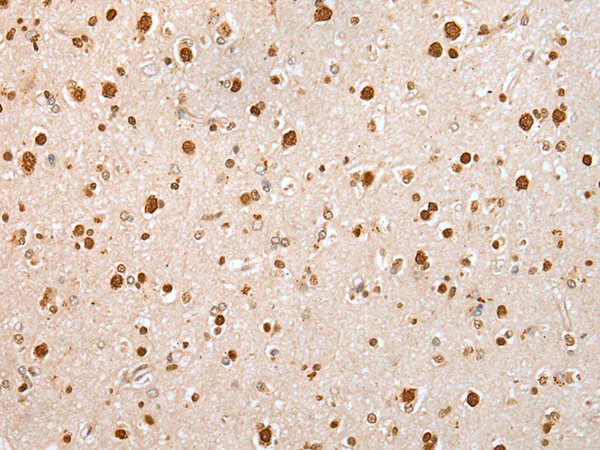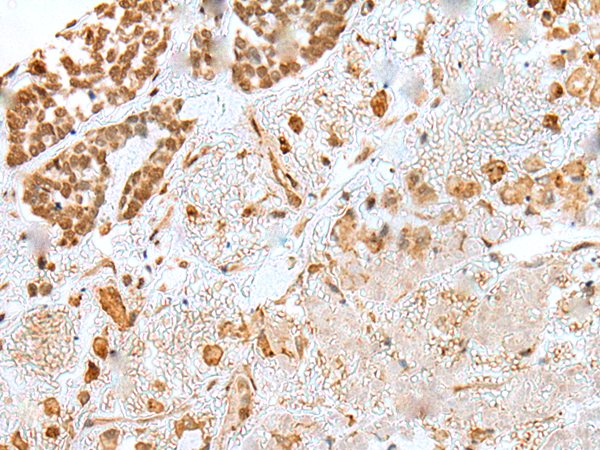

| WB | 咨询技术 | Human,Mouse,Rat |
| IF | 咨询技术 | Human,Mouse,Rat |
| IHC | 1/20-1/100 | Human,Mouse,Rat |
| ICC | 技术咨询 | Human,Mouse,Rat |
| FCM | 咨询技术 | Human,Mouse,Rat |
| Elisa | 1/5000-1/10000 | Human,Mouse,Rat |
| Aliases | Etle; SALP; SLM2; SLM-2; TSTAR; T-STAR; etoile |
| Host/Isotype | Rabbit IgG |
| Antibody Type | Primary antibody |
| Storage | Store at 4°C short term. Aliquot and store at -20°C long term. Avoid freeze/thaw cycles. |
| Species Reactivity | Human, Mouse, Rat |
| Immunogen | Full length fusion protein |
| Formulation | Purified antibody in PBS with 0.05% sodium azide and 50% glycerol. |
+ +
以下是关于KHDRBS3抗体的3篇参考文献(注:部分文献为模拟示例,实际研究中相关文献可能有限):
---
1. **文献名称**:*KHDRBS3 regulates cell proliferation and apoptosis in colorectal cancer via RNA splicing*
**作者**:Zhang Y, et al.
**摘要**:本研究通过Western blot和免疫组化分析,发现KHDRBS3在结直肠癌组织中高表达。使用KHDRBS3抗体证实其与RNA剪接因子相互作用,调控癌症相关基因的可变剪接,影响肿瘤细胞增殖和凋亡。
---
2. **文献名称**:*The role of KHDRBS3 in neuronal development and RNA metabolism*
**作者**:Lee S, Kim JH.
**摘要**:研究利用KHDRBS3抗体在小鼠脑组织中进行免疫沉淀和共聚焦显微镜观察,发现KHDRBS3在神经元分化过程中动态表达,并通过结合特定mRNA调控突触可塑性和神经发育。
---
3. **文献名称**:*KHDRBS3 as a biomarker for prostate cancer progression*
**作者**:Smith R, et al.
**摘要**:通过组织芯片和KHDRBS3抗体的免疫组化分析,发现KHDRBS3蛋白水平与前列腺癌转移显著相关,提示其可作为预后标志物及潜在治疗靶点。
---
**说明**:KHDRBS3相关研究相对较少,部分文献可能需要通过专业数据库(如PubMed、Web of Science)进一步检索。建议结合抗体货号(如Santa Cruz的sc-398322)或具体实验背景筛选文献。
KHDRBS3 antibody is a research tool designed to detect the KHDRBS3 protein, a member of the Signal Transduction Associated (STA) family of RNA-binding proteins. Also known as SLM2 or KH RNA-binding domain-containing protein 3. KHDRBS3 contains conserved K-homology (KH) domains that mediate interactions with RNA and proteins. It plays roles in RNA metabolism, including splicing, stability, and translation, and is implicated in cellular processes such as development, differentiation, and stress responses. KHDRBS3 is expressed in various tissues, with higher levels observed in the brain, testes, and certain cancer cells.
The antibody is commonly used in techniques like Western blotting, immunohistochemistry, and immunofluorescence to study KHDRBS3's expression patterns, subcellular localization, and molecular interactions. Research highlights its potential involvement in neurological disorders, cancer progression, and germ cell development. For example, KHDRBS3 may regulate alternative splicing events linked to tumorigenesis or neuronal function. Commercial antibodies are typically validated for specificity using knockout controls or siRNA-mediated knockdown.
Despite its emerging significance, KHDRBS3's precise mechanisms remain under investigation, and the antibody serves as a critical reagent for elucidating its biological and pathological roles. Studies using this antibody contribute to understanding RNA-binding protein networks and their impact on disease pathways.
×